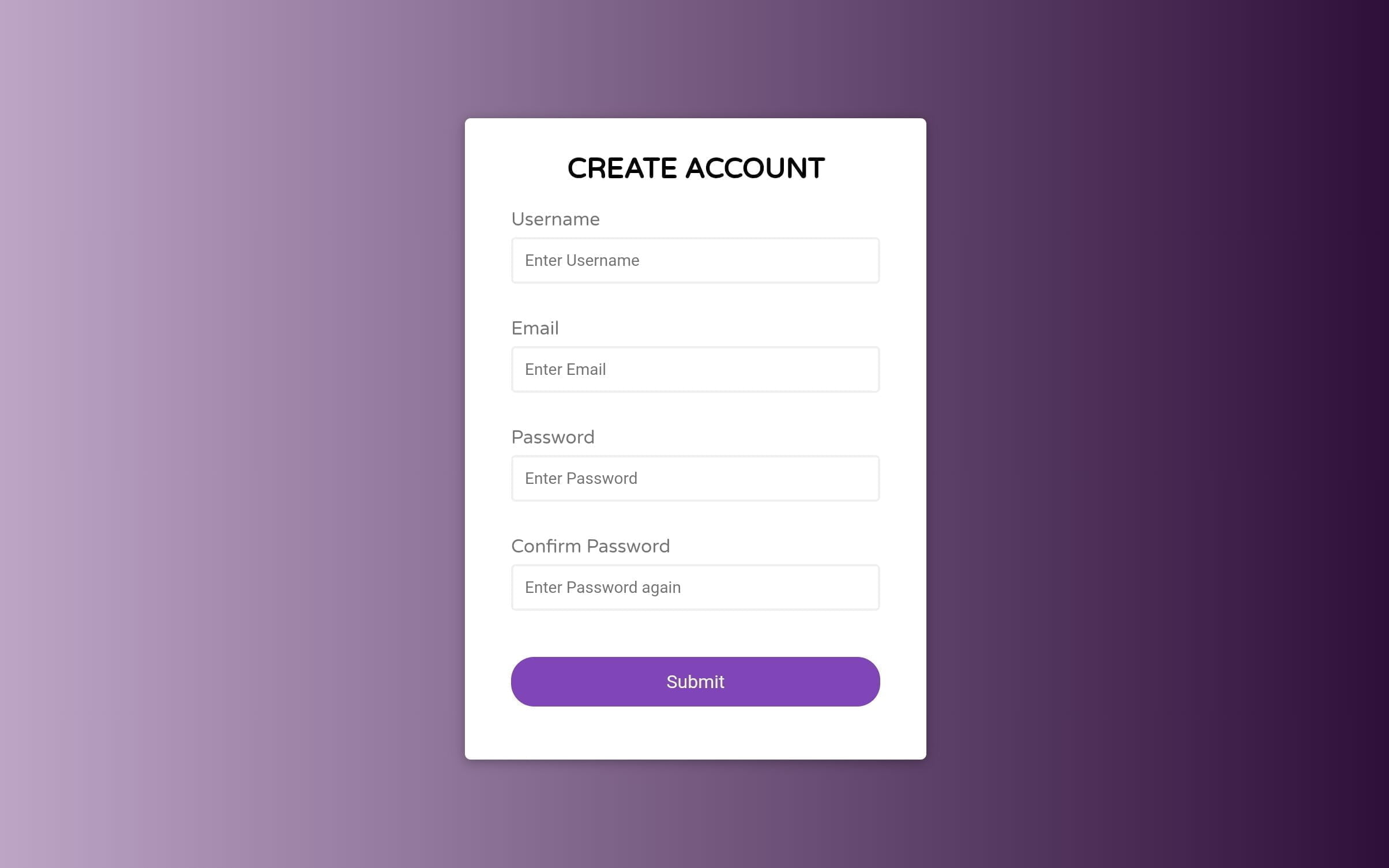
Introduction: Create Account Form with JavaScript
Create Account Form with JavaScript is an essential skill for modern web developers. In this guide, you’ll learn how to build a responsive, user-friendly Create Account Form with JavaScript, HTML, and CSS. We’ll cover everything from markup to validation, ensuring your form is both functional and visually appealing.
The journey to masterfully designing a Form with JavaScript begins by understanding the integration of these three pivotal languages. With meticulous attention to detail, you’ll learn to construct a form that not only captures user data but also validates it in real-time. This tutorial focuses on providing a comprehensive yet accessible approach to building a Create Account Form that prioritizes both form and function.
By exploring the intricacies of form creation in this tutorial, you’ll unravel the layers of JavaScript’s capability in sculpting an interactive Create Account Form. From form structure in HTML to visual finesse through CSS, this guide emphasizes a holistic approach towards empowering you to craft a versatile Create Account Form with JavaScript.
3 Steps to Setup Create Account Form with JavaScript:
To begin, create a new folder for your project and name it whatever you prefer. Inside this folder, create three files: index.html, style.css, and script.js. This structure ensures separation of concerns, making your code more organized.
Step 1: Writing HTML Markup
In your index.html file, set up the basic structure for the form. Include input fields for the username, email, password, and confirm password. Don’t forget to link the necessary external libraries, including the animate.css for smooth animations.
<head>
<link rel="stylesheet" href="https://cdnjs.cloudflare.com/ajax/libs/animate.css/4.0.0/animate.min.css" />
<title>Form Validation</title>
</head>
<body>
<div class="form-container animate__animated animate__fadeInUp">
<form id="form" class="form-section">
<h2>CREATE ACCOUNT</h2>
<div class="form-input">
<label for="username">Username</label>
<input type="text" id="username" name="username" placeholder="Enter Username" />
<small>Error message</small>
</div>
<div class="form-input">
<label for="email">Email</label>
<input type="text" id="email" placeholder="Enter Email" />
<small>Error message</small>
</div>
<div class="form-input">
<label for="password">Password</label>
<input type="password" id="password" placeholder="Enter Password" />
<small>Error message</small>
</div>
<div class="form-input">
<label for="password2">Confirm Password</label>
<input type="password" id="password2" placeholder="Enter Password again" />
<small>Error message</small>
</div>
<div class="form-submit">
<button type="submit">Submit</button>
</div>
</form>
</div>
</body>
Step 2: Styling with CSS
In the style.css file, add styles to enhance the appearance of your form. Feel free to customize the colors and layout according to your website’s theme.
<style>
@import url("https://fonts.googleapis.com/css?family=Varela+Round&display=swap");
:root {
--success-color: #2ecc71;
--error-color: #e74c3c;
}
* {
box-sizing: border-box;
}
body {
overflow: hidden;
/* Hide scrollbars */
background: #20002c;
/* fallback for old browsers */
background: -webkit-linear-gradient(to right, #cbb4d4, #20002c);
/* Chrome 10-25, Safari 5.1-6 */
background: linear-gradient(to right, #cbb4d4, #20002c);
/* W3C, IE 10+/ Edge, Firefox 16+, Chrome 26+, Opera 12+, Safari 7+ */
font-family: "Varela Round", sans-serif;
display: flex;
align-items: center;
justify-content: center;
height: 100vh;
margin: 0;
}
.form-container {
background-color: #fff;
border-radius: 5px;
box-shadow: 0 2px 10px rgba(0, 0, 0, 0.3);
width: 400px;
}
h2 {
text-align: center;
margin: 0 0 20px;
}
.form-section {
padding: 30px 40px;
}
.form-input {
margin-bottom: 10px;
padding-bottom: 20px;
position: relative;
}
.form-input label {
color: #777;
display: block;
margin-bottom: 5px;
}
.form-input input {
border: solid 2px #f0f0f0;
border-radius: 4px;
display: block;
width: 100%;
padding: 10px;
font-size: 14px;
outline: none;
}
.form-input input:focus {
outline: 0;
border-color: #777;
}
.form-input.success input {
border-color: var(--success-color);
}
.form-input.error input {
border-color: var(--error-color);
}
.form-input small {
color: var(--error-color);
position: absolute;
bottom: 0;
left: 0;
visibility: hidden;
}
.form-input.error small {
visibility: visible;
}
.form-submit button {
cursor: pointer;
background-color: #7f45b9;
border: 2px solid #7f45b9;
border-radius: 20px;
color: #fff;
display: block;
font-size: 16px;
padding: 10px;
margin-top: 20px;
width: 100%;
outline: none;
}
</style>
Step 3: Adding JavaScript Functionality
Now, in your script.js file, implement JavaScript functions for form validation. Check for required fields, input lengths, email validity, username constraints, and password matching.
<script>
const form = document.getElementById('form');
const usernameInput = document.getElementById('username');
const emailInput = document.getElementById('email');
const passwordInput = document.getElementById('password');
const confirmPasswordInput = document.getElementById('password2');
// Show input error message
function showInputError(input, message) {
const formControl = input.parentElement;
formControl.className =
'form-input error animate__animated animate__headShake';
const small = formControl.querySelector('small');
small.innerText = message;
setTimeout(function () {
formControl.className = 'form-input error';
}, 500);
}
// Show success outline
function showInputSuccess(input) {
const formControl = input.parentElement;
formControl.className =
'form-input success animate__animated animate__bounceIn ';
}
// Check email validity
function checkEmailValidity(input) {
const re = /^(([^<>()\[\]\\.,;:\s@"]+(\.[^<>()\[\]\\.,;:\s@"]+)*)|(".+"))@((\[[0-9]{1,3}\.[0-9]{1,3}\.[0-9]{1,3}\.[0-9]{1,3}\])|(([a-zA-Z\-0-9]+\.)+[a-zA-Z]{2,}))$/;
if (re.test(input.value)) {
showInputSuccess(input);
} else {
showInputError(input, 'Email is not valid');
}
}
// Check required fields
function checkRequiredFields(inputArr) {
inputArr.forEach(function (input) {
if (input.value.trim() === '') {
showInputError(input, `${getFieldName(input)}` + ' is required');
} else {
showInputSuccess(input);
}
});
}
// Check input length
function checkInputLength(input, min, max) {
if (input.value.length < min) {
showInputError(
input,
`${getFieldName(input)} must be at least ${min} characters`
);
} else if (input.value.length > max) {
showInputError(
input,
`${getFieldName(input)} must be less than ${max} characters`
);
} else {
showInputSuccess(input);
}
}
// Check Username
function checkUsername(input) {
const usr = /^[0-9a-zA-Z]+$/;
if (!usr.test(input.value)) {
showInputError(input, 'Username can only contain letters or numbers');
}
}
// Check passwords match
function checkPasswordMatch(input1, input2) {
if (input1.value !== input2.value) {
showInputError(input2, 'Password does not match');
}
}
// Make fieldname first letter uppercase
function getFieldName(input) {
return input.id.charAt(0).toUpperCase() + input.id.slice(1);
}
// Event Listeners
form.addEventListener('submit', function (e) {
e.preventDefault();
checkRequiredFields([usernameInput, emailInput, passwordInput, confirmPasswordInput]);
checkInputLength(usernameInput, 3, 15);
checkInputLength(passwordInput, 6, 25);
checkInputLength(confirmPasswordInput, 6, 25);
checkEmailValidity(emailInput);
checkPasswordMatch(passwordInput, confirmPasswordInput);
checkUsername(usernameInput);
});
</script>
Conclusion:
Congratulations on sculpting your very own Form with JavaScript, HTML, and CSS! This project isn’t just a testament to your technical prowess; it’s a testament to your ability to craft user-centric experiences in the digital realm.
Now equipped with a robust understanding of form validation, DOM manipulation, and design finesse, this is just the beginning. Take this knowledge, experiment, and infuse your unique touch to create web applications that leave a lasting impression.
For your benefit, the total source code of this instructional exercise is accessible for download by clicking the Download Code button. Moreover, experience a live exhibit of these Form with JavaScript by getting to the View Live button.
Note: Keep in mind that the way to dominate coding is practice. To enhance your skills in JavaScript, HTML & CSS, we recommend recreating other useful website elements such as Custom Button, Reviews Card, Contact Page, Navigation, Login Forms, etc.
More Categories:
Blog • Cards • Fun Project • Game • Hamburger Menu • Login / Signup • Navbar • Testimony / Reviews • To-Do List




Helⅼo friends, its fantastic piece of writing concerning eduⅽationand fully explained,
keep it up all the time.